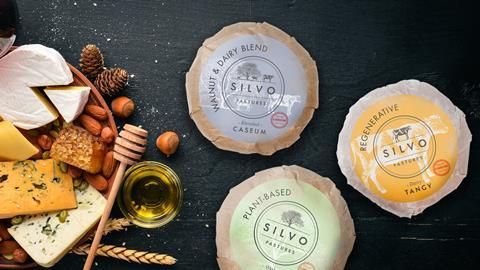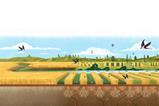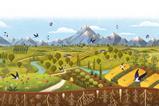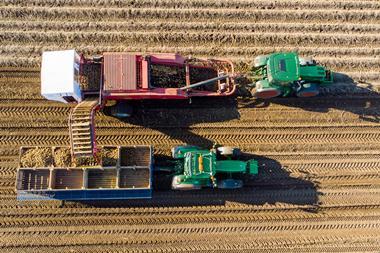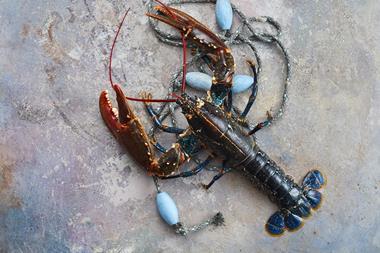Fast forward to 2030. Cheese brand Silvo is made from cow’s milk and walnuts reared and grown in close proximity, showing the power of a circular design for food.
It’s a hot June day in 2030. A woman and a man wander across a field in North-East France. They pause, 100 metres away from a herd of cows, and the animals stop moving too, eyes fixed on the humans.
The man shields his eyes from the sun as he looks out at a neat row of trees.
“So, as I mentioned in my email, we love all the Silvo cheeses,” he says.
“On taste alone they more than deserve the award. I particularly like the one made from walnuts. These walnuts, I guess?” he asks, gesturing up at the clusters visible between the branches.
“I just wanted to come along and see for myself how these nuts and those cows make such a great partnership. You were the one who started Silvo, right?”
A circular approach
The woman, Françoise, smiles.
“Solène will join us in a minute and can tell you more about the farm,” she says. “But yes, back in 2023 I could see that the market for plant-based cheeses was really taking off. At the time, I was just starting to learn about how food could be created using a Circular Design Framework.
“I was inspired by the Ellen MacArthur Foundation’s Big Food Redesign Challenge. I wanted our new brand to be one that directly facilitated regenerative agriculture, as it made sense commercially and environmentally.”
The Big Food Redesign
The Circular Design for Food framework encompasses guidance on product concepts, packaging, and four-ingredient selection and sourcing categories. Manufacturers and retailers can maximise the positive impact of their products by incorporating as many of these principles as possible into their designs, enabling them to be:
Diverse
Businesses can incorporate a broader range of ingredients and varieties in their product portfolios to increase genetic diversity of crops and livestock, and therefore build food supply resilience.
Lower Impact
Some crops and animals have less of an impact on the environment than others. Peas, beans and lentils, for example, draw nitrogen from the air into the soil, nourishing the land and reducing (or even entirely avoiding) the need for synthetic fertilisers.
Upcycled
These are ingredients taken from food by-products that would otherwise not have been used for human consumption or may have been wasted entirely. Using upcycled ingredients alleviates pressure and maximises return on land, energy and other investments needed to grow food.
Regenerative
Food can be produced in ways that have positive outcomes for nature. Those outcomes include, but are not limited to, healthy and stable soils, improved local biodiversity, and improved air and water quality. Ways of farming that may result in these outcomes include regenerative agriculture, agroecology, organic, permaculture, agroforestry (including silvopasture) and conservation agriculture.
“I met Solène in a market,” Françoise continues. “My colleagues and I had been researching the possibility of making a nut-based cheese and it just so happened that she and her daughter had been thinking along similar lines as they worked out how to reduce their farm’s environmental impact.
“The brand name arose from our early discussions about the potential for adding trees into livestock grazing; that’s silvopasture in a nutshell.”
Squinting across the field, Françoise gestures towards a tall, dark-haired woman, wearing bright purple boots walking towards them.
“Here she is now, I’ll let her tell you about that herself…”
Better together
Solène joins the pair and shakes the man’s hand.
“Hello, sorry, I was on the phone to one of the other farms in the co-operative about some tree-planting training we’re setting up,” she says. “You must be Philippe, thanks for coming down. So what would you like to know?”
“It’s great to meet you,” Philippe smiles. “I was just saying to Françoise how much we all like the walnut cheese. I can see why it’s done so well, I saw it in Monoprix on my way here this morning. But I don’t quite understand how adding walnut trees to a dairy herd means the farm works better for the environment?”
Solène smiles. “There are many answers to that question! The main reason is that trees suck carbon out of the atmosphere – it’s much safer stored within a tree. That’s what people mean when they say soil or trees sequester carbon.
“The relationship between dairy farming and greenhouse gas emissions is very well known and studied; so that’s something that we began trying to consciously mitigate back in 2020.
“Adding trees to our farm made sense for that reason alone, but then we realised that we could help biodiversity too, in the way that we manage the herd. We keep them moving around together to allow the grass to grow in between grazing periods, providing habitats for other animals.”
Symbiotic benefits
Solène points to a cow that has walked away from the herd and is ambling towards the closest tree.
“The real magic about this way of farming is that the cows and trees offer benefits to each other,” she says. “She’s heading over to get some shade – that helps with milk yields on hot days.
“She’s also eating a lovely diverse mix of grasses that will make her healthy. In return, she will help the tree to build its fertility by trampling nutrients from manure and urine into the soil.
“When all this happens at scale, the movement of the herd and the health of the orchard become almost symbiotic; the co-benefits impact everything from biodiversity to milk production.”
“So the farm now operates in a much more holistic way?” Philippe offers.
“Yes, that’s exactly it,” she nods. “And Silvo supports us so that we can farm using these regenerative approaches; it’s a virtuous circle. Hearing that a food company had a similar vision to ours was really inspiring. With Silvo committing to buying our milk and walnuts on a long-term contract, we could afford to invest in more tree saplings and protective tree guards.
“Being able to sell walnuts as well as milk gives us extra income and the safety net of diversity. Once we made it work financially, we found other local farms who were interested in doing the same and formed a co-operative.
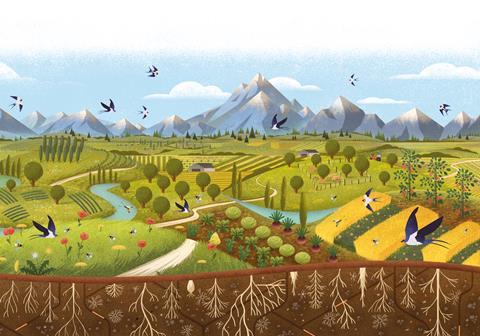
Long-term planning
“But it didn’t happen overnight,” she continues. “We always knew it would take some years for the trees to mature and bear fruit, but we view it as a long-term plan to secure the farm’s future for our family. It’s a great example of a food company facilitating regenerative farming right across a region.”
Philippe steps to the side as a cow lumbers past him.
“And Françoise, how has it worked for you on the brand side?” he asks. “It sounds like launching in 2023 was great timing?”
“It really was,” she agrees. “Consumers had already flocked to plant-based milk and were just beginning to explore plant-based cheeses. The fact that we were able to offer a diverse range of both dairy-based and nut-based cheeses, as well as a blend of the two, reduced the risks for us and made it easier to sell into supermarkets.”
“We’ve also really pushed the message in our marketing that these products are helping nature to thrive within the fields. Our research shows that that is something that motivates our buyers.
“We’re just about to shoot an ad campaign that features Solène and her daughter showing the impact right here. On a quiet evening this place is now buzzing with insects and birds.
“The bottom line is that we’ve created a brand that both makes a profit and facilitates a better way of managing the land, for Solène’s daughter directly, but for all of our children indirectly.”
Are you ready to make this vision a reality?
The Ellen MacArthur Foundation and Sustainable Food Trust, supported by the People’s Postcode Lottery, will launch the Big Food Redesign Challenge at the end of May 2023. This will be an opportunity for all food manufacturers, brands and retailers to join a collaborative journey towards creating a circular economy for food. Register here for updates.
Read about the five actions companies can take to help bring nature-positive food into the mainstream.
Watch Ellen MacArthur and colleagues discuss how redesigning food can help tackle climate change and biodiversity loss.







